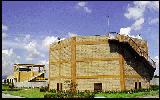 "Flow - Chart of the Trickling Filter Process - 1"...
"Flow - Chart of the Trickling Filter Process - 1"...
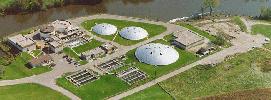
1850 - 1875 : As described by the classic Dickens tale in 1859, "It was the best of times, it was the worst of times...". This literary image poignantly portrays a mid-nineteenth century era freshly endowed with the blessings of an Industrial Revolution, yet virtually helpless in the face of rampant, epidemic disease. Cholera, alone, flared through the British Isles in four deadly outbreaks within one terrifying ten year period. Without question, these problems with communicable disease provide a sad reflection on the existing deficiencies in environmental sanitation. However, the concurrent infancy of bacteriology yielded only vague clues regarding the dangerous correlation between fecal contamination and disease transmission. Existing efforts towards sewage disposal, let alone treatment, were virtually non-existent. Certainly it was fortuitous, then, that legislation (i.e., the Nuisance Removal Act) was enacted in 1858 to control sewage discharge, albeit more so a function of safeguarding aesthetics rather than a perceived health hazard. This emphasis quickly shifted towards disease control, though, following Dr. John Snow's monumental publication on epidemiology within the same year. England shortly organized a series of Royal Committees charged with the study of problems relating to sewage disposal and treatment. Their initial findings categorized the existing state-of-the-art according to chemical precipitation, filtration and irrigation, with the latter two procedures generally associated with land treatment. While land systems carried a traditional background extending several centuries, some of the other available options were rather curious. One such precipitation procedure, the ABC process, employed a bizarre mixture of alum, blood and clay.

None of the available treatment mechanisms were, however, recognized as biologically-related systems. Hence, Dr. Alexander Mueller's demonstration in 1865 that sewage could be purified by living organisms in a filtration column provided a major revelation. Dr. Mueller, a prominent City Chemist of Berlin, subsequently patented his biological purification process several years later. Unquestionably avant-garde, neither the patent nor the fundamental concept attracted much attention, though. In 1868, one of the Commission members, Sir Edward Frankland, began an epic study of filtration performance on raw London sewage in laboratory columns packed with media ranging from coarse gravel to peaty soil. Using a twice daily dosing pattern, Sir Frankland maintained successful filtration performance for over four months. Although the filter's treatment capability was solely credited to physical-chemical means, the associated establishment of the intermittent filtration concept had notably introduced a necessity for resting or aeration periods between sewage applications. Based on these results, the Royal Commission began to place considerable emphasis on the use of intermittent land filtration. In 1871, J. Bailey-Denton initiated the first full-scale operation at Merthyr Tydvil, Wales. Success at this facility, and others subsequently developed by Bailey-Denton, soon promoted several engineers to apply Frankland's concept. Unfortunately, these engineers oftentimes neglected critical factors such as soil permeability and/or the necessity for intermittent dosing, such that failures became commonplace. And with subsequent documentation of 38 such failures, technical interest in the intermittent concept quickly faded.
1875 - 1900 : Following upon the singular work by Mueller over a decade earlier, several researchers successively explored the microbial aspect of sewage purification. Five years later, Warrington confirmed that sterilized solutions lost their nitrifying ability until inoculated by fresh soil. And in 1890, Winogradsky succeeded in identifying Nitrosomonas bacteria. These pioneers were, however, still uncertain as to the pragmatic application of these bacterial mechanisms to effective treatment. Up to this point, Europe had dominated the developments in wastewater treatment technology. Within the United States, though, comparable concern for pollution control resulted in the establishment of the Lawrence Experimental Station by the Massachusetts State Board of Health. Organization of the Lawrence facility was handled by Hiram F. Mills, a distinguished hydrologist, and Professors Sedwick and Drown from the Massachusetts Institute of Technology. Under the direction of Allen Hazen, the Lawrence group began a series of filtration experiments in 1887 which were comparable to the prior Frankland tests on intermittent dosing. In this case, however, the filters were significantly larger, at 1/200th acre per unit. While their results subsequently verified the treatment potential afforded by an intermittent filtration mechanism, the Lawrence group's first publication in 1890 provided a monumental analysis of the associated microbial activity. Indeed, their findings truly furnished the hallmark demonstration that microorganisms carried within the filter media could degrade sewage in an aerobic environment facilitated by intermittent dosing.

Given the success of the Lawrence experiments, biological treatment systems rapidly expanded in terms of application and sophistication. Considerable controversy had arisen in the 1890's over patent rights obtained by Donald Cameron for septic tanks, such that most municipalities were anxious to find suitable treatment alternatives. Several full-scale intermittent filtration systems were, therefore, constructed in the New England area, most of which were successfully maintained for several decades. In Europe, though, sanitary engineers were still hesitant to accept the intermittent filtration concept. This opinion likely stemmed either from a lingering dissatisfaction with the Frankland-era facilities, or because of the widespread unsuitability of European soil. Instead, they chose to intensify filtration rates using coarser media such as coke breeze, gravel, burnt clay and coarse chalk. Scott-Moncrief probably began the first such tests, using sewage percolation through sequential rays of 1 inch diameter coke media. In 1893, J. Corbett also employed a serial filter scheme, with an additional wooden trough to continuously distribute influent sewage across the bed. And in the same year, F. Wallis Stoddart reported on the use of a course media filter receiving a continuous, trickling flow. Of these two latter researchers, Corbett acknowledged the impetus and direction provided by the previous Lawrence findings. Stoddart, however, insisted that his work stemmed from Frankland's principles and that his continuously percolated units were the first of their kind. In either case, the trickling filter had been conceived.
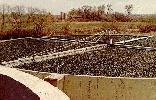
Another classic European option which developed at much the same time was the contact bed. Acting along the lines of the Lawrence experiments, W. Santo Crimp and W. J. Dibdin decided in 1891 to experiment with a dosing pattern which flooded a coarse media filtration bed for 8 hours, followed by 16 hours in a drained state. Of the coarse media materials tested on chemically-treated London sewage, Dibdin found that the coke breeze provided satisfactory treatment, while sand clogged extensively. In subsequent tests, Dibdin experimented with a double-contact approach, using primary and secondary beds respectively containing successively smaller media. The success of this operation quickly led to several full-scale installations, all of which maintained the cyclic fill, drain and react periods. And in their fifth report, the Royal Commission provided extensive technical support for the installation and operation of such contact beds. Dosing strategies for both the trickling filters and contact bed systems received intensive study in the years immediately following their development. For uniform loading of intermittent filter units, Waring and Lowcock devised a simplistic technique in 1892 based on an overlying fine gravel layer to promote equivalent flow distribution. However, this procedure retarded desired bed aeration. Perhaps as a consequence, Waring also devised and patented a trickling filter system which employed forced aeration.
Stoddart's approach to flow distribution was that of corrugated sheet-metal plates with symmetrical discharge ports. Although considered satisfactory, leveling of these horizontal plates required tedious adjustment. Corbett initially used slotted wooden troughs and then switched to a variety of fixed-spray jets. In 1896, Carfield improved the fixed distributor concept by adding an intermittent dosing tank. The siphon action insured an intermittent dosing procedure which prevented localized flooding at the media. Rotary flow distributors were originally tested in 1889, with additional refinement by Corbett in 1894. Two years later, Whittaker and Bryant introduced a rotary sprinkler equipped with a pulsometer. This latter addition not only produced a pulsed, intermittent flow, but also warmed the influent sewage. However, their model employed perforated pipe distribution arms prone to clogging. Rotary wooden troughs were then introduced by Mather and Platt to avoid this plugging problem.
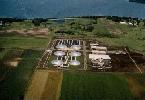
1900 - 1925 : Given the classic technical advancements made by Hazen, Stoddart, Corbett and Dibdin in the past quarter century, the next twenty-five years could be viewed as an era of practical application and refinement. Of the available biological treatment system (i.e., intermittent filtration, trickling filters and contact beds), it is interesting to note that each comprised a fixed-film process. Rudimental experiments in sewage aeration were underway at the time, but suspended growth systems did not originate for several years. Trickling filters were first introduced to the US in 1901 at Madison, Wisconsin. By 1910, several additions in mid-west and eastern cities brought the total to ten. Monumental in size alone, the 31 acre Baltimore trickling filter system is remarkably still in operation some seventy-five years after its initial development. Among these early US trickling filter units, and for several decades, fixed spray jets served as the norm for flow distribution. Contemporary sewage treatment texts typically carried several pages devoted to spray jet design and installation. In most cases, these distributions were also equipped with siphon dosing tanks. While rotating distributors were only randomly tested in the United States (i.e. Springfield, MO in 1912 and Pontiac, MI in 1920), European trickling filter designs favored the rotary or traveling sprinkler approach.
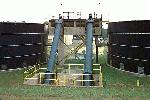
With the advent of trickling filter applications, interest in intermittent-filtration began to fade. Experimentation continued on both options at Lawrence, demonstrating that the higher loading rates provided by coarse media design could significantly reduce the requisite land area. Mathematical modeling of these biological filters was also initiated in 1916 by Tatham. In using a mass-balance derivation based on first-order kinetics, this study classically sought to define the purification process according to precise chemical engineering principles. As for contact bed design, several full-scale applications were recorded. Although a few large scale units were built in the United States, contact beds did not receive much interest outside Europe. Because of the involved flooding routine, anaerobic conditions tended to lower final effluent quality. This circumstance, combined with frequent clogging of the bed media by entrained sludge, certainly began to cast doubts on the usefulness of contact bed treatment. Recognizing the desirability of an aerobic biofilm, Dibdin decided in 1904 to experiment with forced bed aeration. And to facilitate flushing solid matter from the bed, the coarse media was replaced with slate slabs packed in horizontal layers. Operation of the modified unit still followed the phased fill-and-draw routine. After twelve months of laboratory study, Dibdin successfully progressed to a full-scale demonstration of his slate bed design at Devizes in 1905. However, in their fifth report, the Royal Commission indicated that the slate bed approach should only be considered as a primary sedimentation mechanism.
Within the US, Dibdin's slate bed technique drew immediate interest. Experimental testing was initiated in Plainfield, New Jersey in 1905. Historically important experimentation on slate bed treatment was also begun at Lawrence under the direction of H. W. Clark and S. Gage. In comparing aerated slate bed units and aerated bottles containing algal suspensions, these investigators reported in 1913 that the bottles provided better treatment efficiency. This variance was attributed to a failure by the previously scrapped slate plates to accumulate a suitable biofilm during the short period of study. Shortly thereafter, Gilbert John Fowler, a British Professor of Chemistry at Victoria University, visited the Lawrence labs and witnessed these same experiments. Upon returning to England, Dr. Fowler's students Edward Ardern and William Lockett began the historic study of suspended growth treatment. In 1914, these two students then published the first account of an activated sludge process; sticking with the accepted intermittent (i.e. fill-and-draw) pattern, but distinctively switching to a suspended biomass. Speaking on behalf of his students, Fowler did acknowledge the contributing and inspiration provided by Clark and Gage, referring to Lawrence as "the Mecca of sewage purification...".
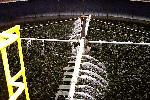
In much the same vein as Dibdin's slate bed, Dr. William Owen Travis also sought to improve upon the contact bed procedure. As the local health officer in charge of a contact filter at Hampton, England, Dr. Travis was quite familiar with the problem of bed clogging. His solution, introduced in 1904 as the Travis Hydrolytic or Colloider Tank, was essentially configured as a multi-stage septic tank. Successively divided into detritus, hydrolytic and finishing tanks, the latter two zones contained wooden colloider baffles or laths placed in a parallel array. These baffles were intended to attract fine particulates for subsequent degradation. Only one such plant was ever built, at Norwich, England in 1909. The construction at another Travis facility by the Emscher Drainage District Board was discontinued after the death of the involved design engineer, Wattenberg. His replacement, Karl Imhoff, subsequently convinced the Board to switch to his personal design, known thereafter as the Emscher or Imhoff Tank. As a footnote to this era, mention should also be made of two unique patents obtained for rotating support media. The first, conceived by Weigand in 1900, comprised a moving cylinder with wooden slats. Poujoulat's patent in 1916 employed agglomerated slag or porous brick fashioned as a hollow cylinder and rotated about its horizontal axis. Flow distribution was provided using a perforated pipe placed over the cylinder. Although neither option attracted much attention at the time, these designs could well be considered vintage predecessors to rotating biological contactor technology.
1925 - 1950 : Over the next twenty-five years, intermittent filtration and contact bed systems were effectively discarded in favor of trickling filter design. Within the US, extensive efforts were made to improve and upgrade trickling filter performance, including the development and adoption of technical standards for design loading, bed construction and system operation. High-rate designs, developed to increase hydraulic capacity, were marketed by several companies, including: Lakeside Engineering (Aero-filter), Dorr/Link-Belt Comp. (Bio-filter) and Infilco (Accelo-filter). In most cases, fixed-spray jets were also discarded in favor of rotating distributor systems. Much of the popularity of these trickling filter units could certainly be attributed to their relative simplicity, ease of operation and cost-effective performance capabilities. Activated sludge was still a somewhat innovative process, and one which prompted considerable concern regarding its intensive energy demand for aeration. Legal problems also plagued the activated sludge process, with costly patent infringement suits filed against several major cities by Activated Sludge, Ltd. Many municipalities consequently turned away from suspended growth systems in favor of the more conservative trickling filter option.
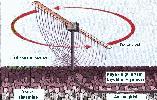
There were, however, several tangential developments in fixed-film technology which deserve considerations. The application of one such option, the Hays process, actually rivaled the installation of trickling filters for the period of 1930 to 1940. Developed in 1930 by Clifford Hays, a chemist from Waco, Texas, this procedure employed large asbestos-concrete sheets vertically stacked with a 1" to 2" spacing. This design approach was physically analogous to the Dibdin slate bed (although vertically arrayed, rather than horizontal) or the Travis colloider system (with the added feature of a diffused aeration system). By 1942, there were 63 such units in operatoin throughout the US, many of which were located at military installations. However, the limited availability of corrugated asbestos-concrete sheets during wartime conditions necessitated the use of flat sheets. Lacking surface rigidity, these latter sheets frequently buckled and collapsed, resulting in process failures which doomed its future consideration. Another such resurrected concept was that of the Nidus Rack. Developed by A. M. Buswell in 1929, the Nidus Rack was intended to advance the Travis Colloider principle by significantly increasing the surface area for colloid/particulate attraction. Numerous woven lattice units constructed of veneer or basket wood were placed into a contact tank and mechanically agitated to promote deposition into an underlying settling compartment. Buswell's article also mentions a number of related studies incorporating straw and corncob filter arrays. Following along the research line established by Weigand and Poujoulat, a number of investigators independently studied the use of rotating support media. J. Doman reported in 1929 on the development of a contact filter using partially submerged rotating plates constructed from galvanized steel. The schematic overview provided with this report bears a striking resemblance to modern RBC designs. One further option on rotating media, the Biological Wheel, was patented by A. T. Maltby shortly before 1930. The unit consisted of a series of paddle wheels partially submerged in, and rotated by, sewage flowing through a surrounding channel. Biofilm attached to these wheels consequently rotated in alternating fashion through the sewage and into the atmosphere.
1950 - Present : Mohlman's Sewage Works Journal editorial entitled, "Revival of the Trickling Filter," provides an excellent commentary on the mid-twentieth century state-of-the-art for fixed-film systems. Despite referencing the relative advantages of system reliability and economy, this editorial acknowledged that trickling filters, "were almost relegated to limbo". Indeed, over the next few years, conventional tricking filter construction using rock media was unquestionably surpassed by activated sludge. Mohlman also provided a timely reference to the related technologies recently developed by Buswell, Maltby, Doman and others. In essence, he collectively defended fixed-film treatments a worthy alternative to the rapidly advancing suspended-growth concept. At much the same time, significant developments were occurring with the incorporation of plastic-based support media into various fixed-film treatment systems. These synthesized media forms offered several advantages over naturally available materials particularly in terms of surface contact area, voidage fraction, packing density, and construction flexibility. Research and development on plastic media proceeded along two distinct lines during the early 1950's. In America, bundled plastic units were being proposed and tested as innovative packing for stationary filter applications. Investigators in Europe, though, began testing rotating plastic discs in much the same manner as Doman's rotating cast iron system. These latter researchers at Stuggart University, West Germany, conducted extensive testing on wooden and plastic discs, 1 meter in diameter. Further improvement by Popel and Hartman led to the use of expanded polystyrene media which then opened the door for commercial application.
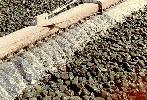
By 1957, the J. Conrad Stengelin Company in Tuttlingen, West Germany had begun manufacturing expanded polystyrene discs 2 and 3 meters in diameter for use in wastewater treatment plants. The first commercial installation went into operation in 1960, and soon thereafter the process began to attract considerable interest through Europe. During the early 1960's, the research division of Allis Chalmers Corporation also investigated the use of rotating discs in various chemical processing applications. Their disc was called a two-phase contactor (TPC), and was tested for applications of gas absorption and stripping, liquid-liquid extraction, liquid-liquid heat transfer, and other mass and energy transfer applications. Eventually, the device was considered for oxygen transfer. In the summer of 1965, three-foot diameter metal discs were evaluated at the Jones Island treatment plant in Milwaukee, Wisconsin. These units were initially employed for oxygen transfer in an extended aeration process, and then tested without sludge recycle and with an attached biomass (i.e. as a biological contactor). [In retrospect, the Jones Island site was an ironic location, as it represent the original application of activated sludge on a large commercial basis.] To confirm the favorable results of these initial tests and to learn more about the treatment process, laboratory tests were subsequently conducted using a synthetic dairy waste and 3-foot diameter aluminum discs. After learning of the European activities, Allis-Chalmers reached a licensing agreement in 1968 with the German manufacturer for production and sales distribution in the US. The treatment process was marketed under the trade name Bio-Disc. The first commercial installation in the US went into operation at a small cheese factory in 1969.
 "Flow - Chart of the Trickling Filter Process - 2"...
"Flow - Chart of the Trickling Filter Process - 2"...
In 1970, Allis-Chalmers sold its rotating biological contactor technology to Autotrol Corporation. At that time, polystyrene discs were still not competitive with the activated sludge process, primarily due to the high capital cost of the polystyrene discs. However, in 1972, Autotrol announced the development of new rotating contactor media constructed from corrugated sheets of polyethylene. Until then, the RBC unit consisted of a series of parallel, flat 0.5 inch thick expanded polystyrene sheets, each separated by a 0.75 inch space. The new arrangement used 1/16 inch thick polyethylene sheets with a 1.2 inch space. At much the same time (i.e. early 1950's) that the West German researchers began exploring plastic RBC's, American investigators at Dow Chemical Company were initiating their experiments with the production and use at plastic packing media. Two initial plastic units were devised at Dow including a modified "berl-saddle" (trademarked as Dowpac FN-90) and bundled arrays of nested, corrugated sheets (trademarked as Dowpac HCS). Dow subsequently reassigned the Dowpac term, substituting it with "Surfpac". Pilot-scale tests were conducted on both Dow packing materials using various types of industrial wastes. Both performed acceptably well, but future emphasis was given to the bundled form (i.e. Dowpac HCS) because of its perceived cost-effectiveness and operational flexibility. This material was designed to distribute falling liquid wastes in thin films over large surface areas to that maximum efficiency of contact with aerobic microorganisms was attained. It provided a high percentage of void space for unimpeded draft circulation and waste flow. It provided large surface area adherence of biological slimes. The material produced by Dow Chemical Company consisted of individual sheets of polystyrene or Saran plastic material, corrugated in two directions, having dimensions of 3 ft. by 1.75 ft.
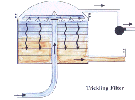
The individual sheets were typically shipped stacked in bundles, and then assembled into structurally self-supporting modules at the point of use. In assembly, the sheets provided approximately 1 inch of free space. These modules were laid in the filter structure in a layered grid pattern to provide good distribution of flow of liquid, and to assist in structural stability. Void space within the assembled filter bed was about 94 percent. Assembled weight of the individual modules was 4 to 6 lb/ft3. This enables the modules to be stacked to depths of 30 to 40 feet, conserving the use of land space. Generally operated as aerobic systems, these latter packed bed units typically receive a trickling flow which facilitates desired tower ventilation. Submerged contact has been recently tested, though, both for aerobic and anaerobic treatment. Tunick et. al. and Hines and Weeter have accordingly reported on the behavior of upflow anaerobic contact systems packed with selected media materials. A down-flow submerged contact process has also been marketed by Cytox, incorporating a parallel array of vertically stacked plastic sheets. Continuous fluid recycle within the vessel is directed towards a splash pad above the tank which then promotes oxygen transport. Aside from this latter aeration mechanism, the Cytox system could well be considered a resurrected Hays process. Another option for submerged media will be presented by a subsequent author, Li and Whang. This unique approach employs a synthetic ribbon media design which is then unfurled and weighted to maintain extension.
